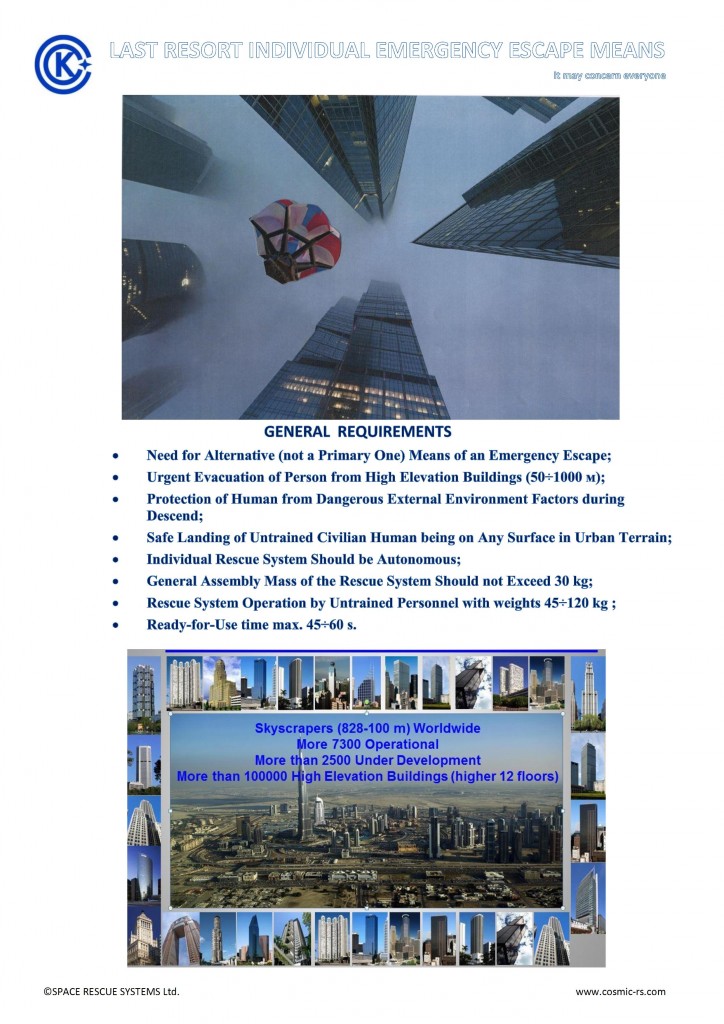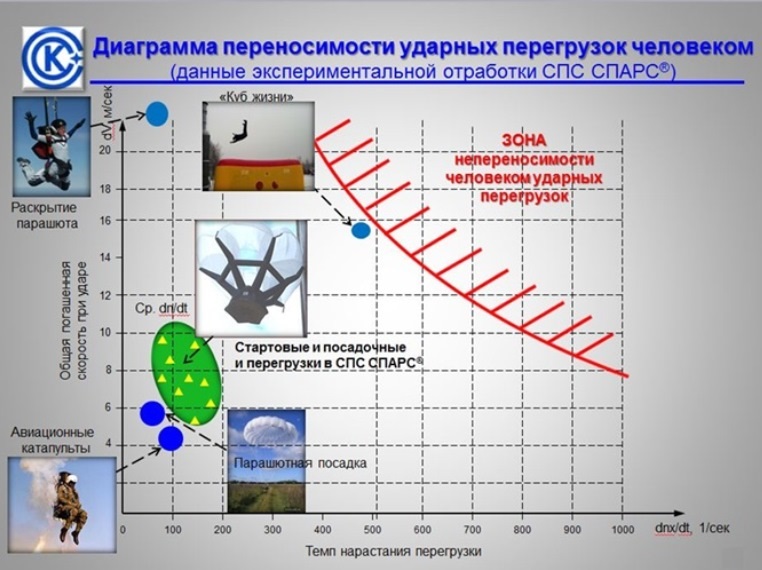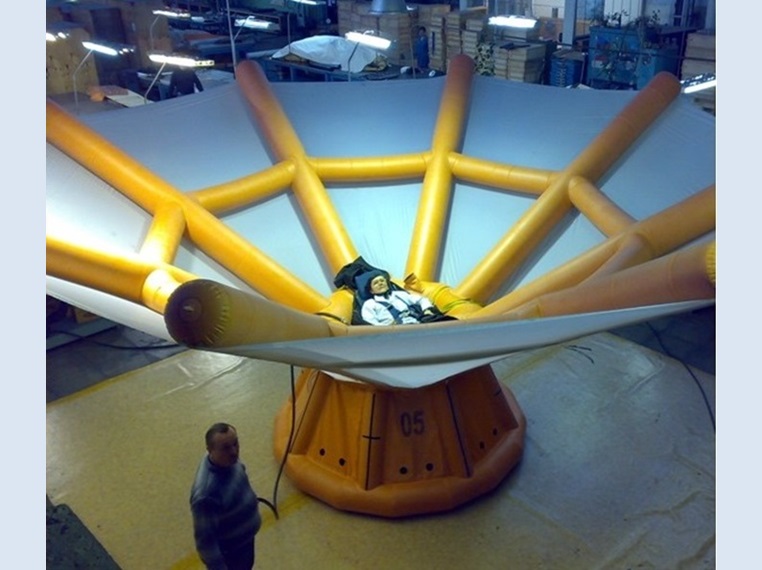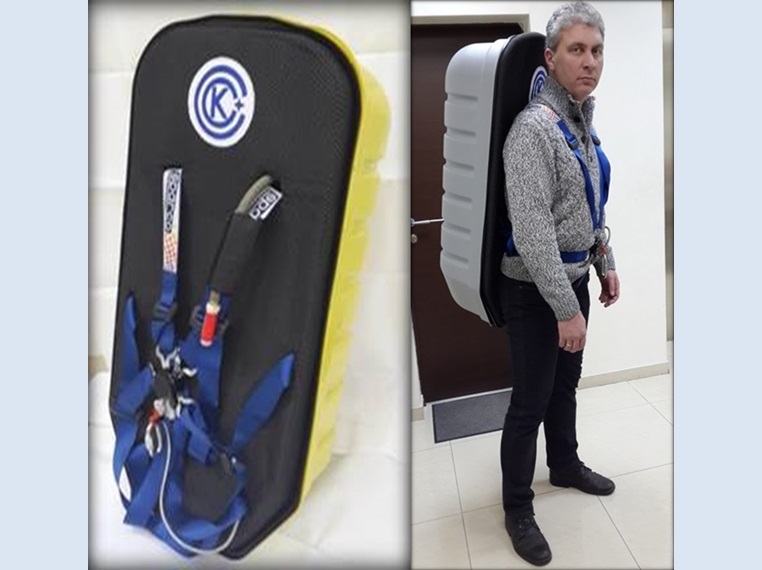SPARS®


 Pioneer development of new class individual free-pancakes systems – Autonomous Rescue Parashuting Pneumo-Transformable Back-pack System (SPARS®, TU 1130-5047075064-01-10) for personal rescue of untrained people and valuable cargoes from high-rise facilities, for example, upper floors of high-elevation buildings in case of a fire or other emergency situations, when evacuation using traditional methods is impossible. Found: 3 trademarks, 22 patents including 13 foreign patents. SPARS® technology meets the EMERCOM requirements for high-rise emergency escape apparatus (GOST R 22.9.08–2005; GOST R 12.4.206–99).
Pioneer development of new class individual free-pancakes systems – Autonomous Rescue Parashuting Pneumo-Transformable Back-pack System (SPARS®, TU 1130-5047075064-01-10) for personal rescue of untrained people and valuable cargoes from high-rise facilities, for example, upper floors of high-elevation buildings in case of a fire or other emergency situations, when evacuation using traditional methods is impossible. Found: 3 trademarks, 22 patents including 13 foreign patents. SPARS® technology meets the EMERCOM requirements for high-rise emergency escape apparatus (GOST R 22.9.08–2005; GOST R 12.4.206–99).
The Space Rescue Systems Ltd. (SRS Ltd.), using aerospace re-entry and pneumatic air-bag damping technology, designed, developed, tested and prodused test batch of a unuque inflatable aerodinamic deceleration device – Autonomous Rescue Parashuting Pneumo-Transformable Back-pack System named SPARS®.
Autonomous Rescue Parashuting Pneumo-Transformable Back-pack System SPARS® is for personal rescue of untrained people and valuable cargoes from high-rise facilities in case of emergency situations, when evacuation using traditional methods is impossible.
The concept of inflatable devices is used as a prototype of the SPARS® technology to slow the spacecraft, provide soft landings. It was used in space projects of FSUE “NPO Lavochkin” and Roscosmos (Khimki, Moscow region).
Synergistic approach was implemented in the comprehensively tested and validated SPARS® technology. The approach lies in the constructive and properties of the inflatable outboard gas (air) tissue-film single-volume pneumoframe shell. At the same time this shell and the screen-dome system form cone-shaped aerodynamic braking device (PARAKON®). PARAKON® has the properties of an effective stabilization and orientation, forms a pneumatic-elastic damping device.
The SRS Ltd. fulfilled scale R&D activities in cooperation with 19 Russian and foreign firms in order to develop product that meet the current level of technology development.
SPARS® meets the EMERCOM requirements for high-rise emergency escape apparatus (GOST R 22.9.08–2005; GOST R 12.4.206–99) and provides for the following unique capabilities, never implemented before:
- Emergency evacuation of an untrained person having weight of 45-120 kg, from heights of 5-1,000 m;
- Ready-for-use in 45-60 sec;
- Self-sustained operation and independently selected escape route;
- User-friendly operation for untrained persons and fully automated rescue procedure right from start;
- Personal protection against external hazards during evacuation;
- Secure injury-free landing on any urbanarea surface;
- Appropriate weight of a back-pack-type carried device (not more than 25 kg);
- Alternative of emergency escape (socalled “last resort” facility).
From medical-technical point of view the SPARS® fully corresponds to the Russian National Sandart GOST 4240-001-12 concerning civil human being toleration and protection from multidirectional shock accelerations affection.
The Test Center for Aviation and Space Medicine and Military Ergonomics of Ministry of Defence of the Russian Federation gave the official conclusion of the physiological applicability SPARS® for untrained users at the age of 18-70.
The SPARS® General Specifications:
- Total Assembly Mass – 25 kg;
- Rescue Payload Mass – 45÷120 kg;
- Descent Elevations – 5÷1000;
- Landing Velocity – 5÷7 m/s;
- Landing Angle – < 30°;
- Footboard Barrier Elevation ̶ 1,5 м;
- Descent Time – 3÷150 s;
- Ready-to-use Time – 45÷60 s;
- Launch Initialization Time – 15÷20 s;
- Gas Filling System – air-injection type, 2 cascade, autonomous;
- Inflated Gas – Air;
- General Dimensions:
- Aassembled – 900х450х300 mm
- In Descent mode – 6500х2700 mm (without dome)
Actual Landing Impact Loads:
Acceleration directions
- “chest-to-back” — up to 8÷10 g
- “side-to-side” , “head-to-pelvis” — up to ± 6g
Acceleration Exposition Time — less than 0.5 s
Acceleration Growth Velocity — less than 500 1/s
User’s age — 18÷70 years
SPARS® must be kept in an easily accessible place near the window. When it is packed, it is a container with a backpack harness.
SPARS® is simple and straightforward to use. In case of an emergency, a person must proceed as follows:
- put on a backpack container on back;
- engage the locking rib and leg straps of harness;
- select the optimal escape route;
- engage Homepage-safety tether for the structural element of the building;
- sit on the windowsill with back to the street and secure Homepage-safety tether;
- start the ring-pull handle, which is located in the chest.
After pulling the starter ring-handle, 2 autonomous air cascade ejector system of intensive gas filling is turned and the recovery process takes place in a fully automatic mode.
On a prestarting phase pneumoframework SPARS® is performed and acquires a special prestarting form with the formation of the pnevmokatapulty. The pnevmokatapulty automatically cuts off kickoff-tether and pneumoframework, cracking, intense cheating to the operating pressure of the system. The pnevmokatapulty pushes and pulls out a person from the building. A person must be lying on a special cradle locking system and protected from all sides at all stages of the recovery process.
Screen-dome system of aerodynamic braking SPARS® is forcibly straightened and inserted into the stream. It is a high-performance 6-segment ring parachute. Forced Inflatable smoothing of screen-dome system SPARS® does not require a large dynamic pressure for introduction of the aerodynamic braking into the flow (3-5 meters of height loss). This is in contrast to the classic parachute, required for these purposes from 20 to 70 m of height loss and parachutist’s special skills.
During launching, an inflatable aerodynamic braking device PARAKON® provides damping of SPARS® flight speed to 5.5-7.5 m/c. Emergency evacuation can occur at heights of 5 to 1000 m and above.
When landing, left damping of kinetic energy is provided by pneumatically inflatable cushioning device, which reduces shock overload. It increases the braking time and reduces the overload acting on the rescued person to acceptable values.
The SRS Ltd. Intellectually Property Rights on SPARS® and its «know-hows» have been completely protected within Russia (9 Patens, 3 Trade Marks), and abroad under PCT (Patent Cooperation Treaty) procedures in 13 countries all over the world with 78% of skyscrapers market share, 95% of the potential producers’ market share.








